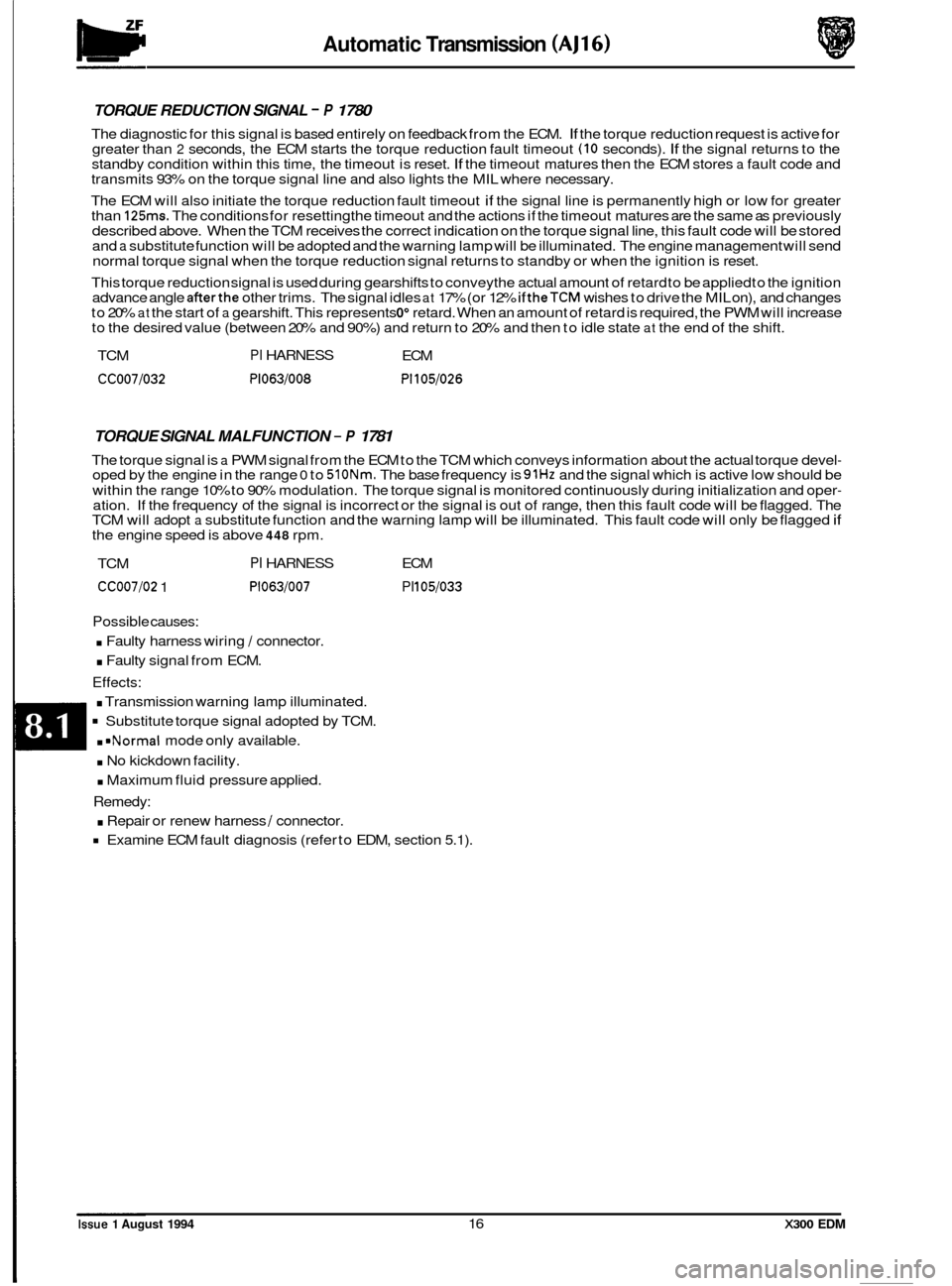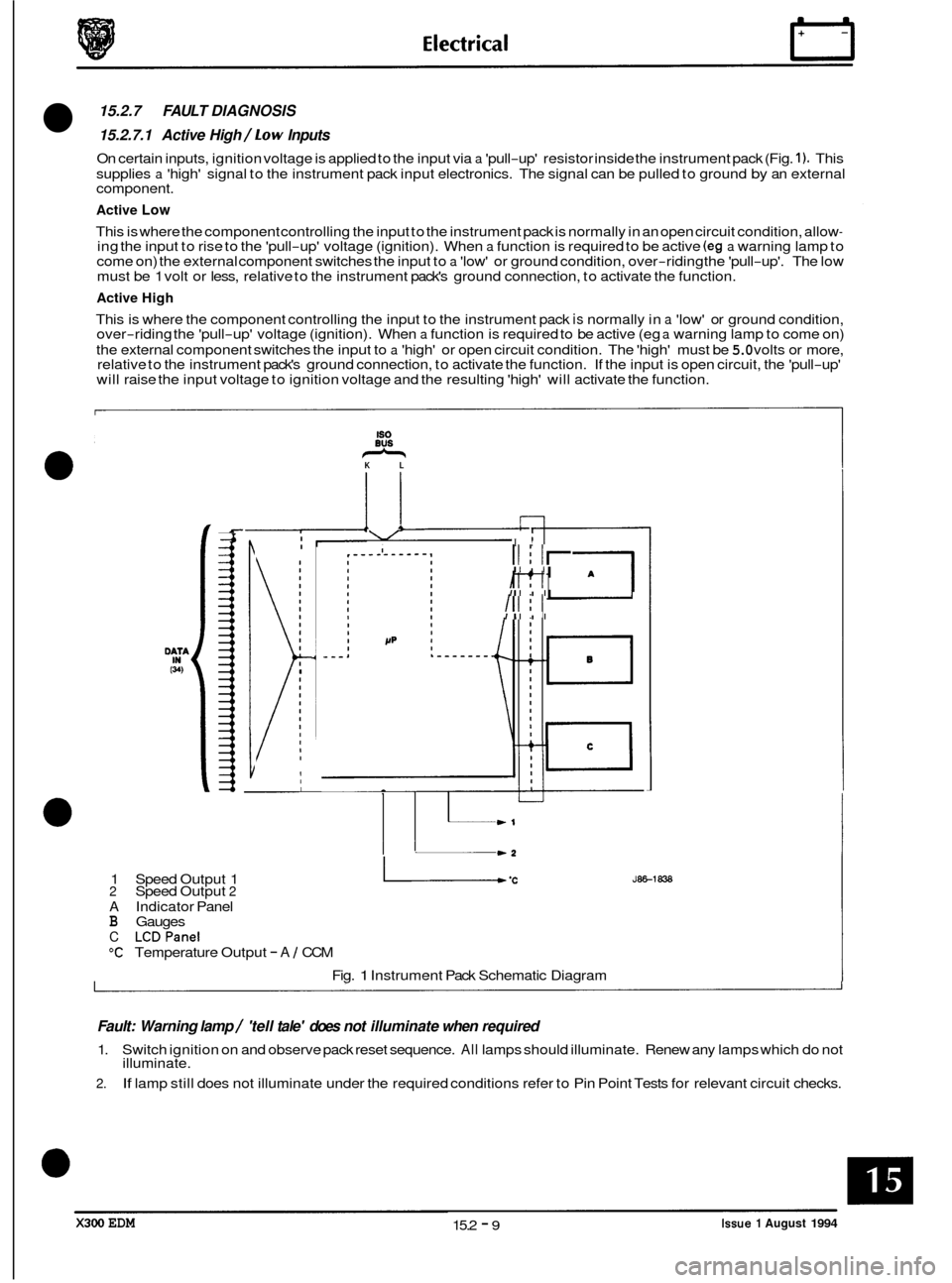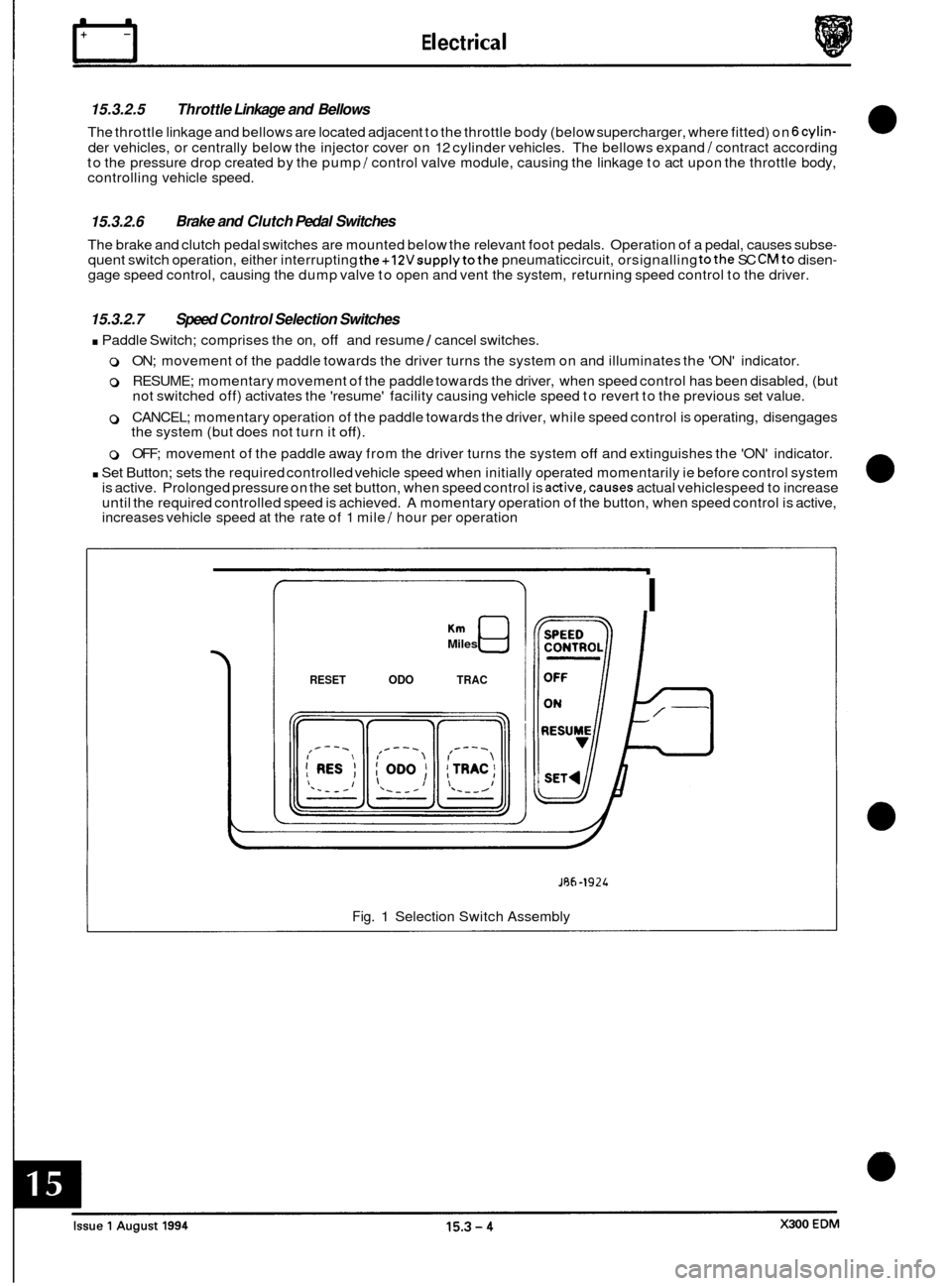1994 JAGUAR XJ6 reset
[x] Cancel search: resetPage 8 of 327

Automatic Transmission (AJ16)
8.1.4 FA U1 T DIAGNOSIS
Transmission Control System Electrical - P 0702 (Fig. 1)
This fault code is associated with the internal relay of the Transmission Control Module, (TCM). This relay provides a
means of isolating the electro-mechanical, controlling, solenoids from the supply, allowing the transmission to revert
to a mechanical default condition.
The relay and associated circuitry is tested once during initialization and whenever
a hardware reset occurs. When the
ignition is first switched on the TCM carries out an initialization routine. During this routine the processor drives the
relay
ON then tests for the supply voltage on the output via a feedback path. If the supply voltage is not seen within
a specific time then
a fault is flagged and the TCM will run in default mode and this fault code will be stored.
A set time after the relay is turned on, it is turned off and the processor then tests for the supply again. If it is still present,
then the TCM will run in default mode and this fault code will be stored.
U: The ignition supply voltage must be greater than 8V for a fault code to be stored. If this fault is permanently
flagged, the TCM should be replaced taking care to obtain the correctly programmed variant.
Possible causes:
Faulty TCM internal relay.
Effects:
. MIL illuminated.
. Transmission warning lamp illuminated.
. Maximum fluid pressure applied.
Limp home mode applied.
. RenewTCM.
Remedy:
Fig. 1
X300 EDM 5 Issue 1 August 1994
Page 19 of 327

Automatic Transmission (AJ16)
TORQUE REDUCTION SIGNAL - P 1780
The diagnostic for this signal is based entirely on feedback from the ECM. If the torque reduction request is active for
greater than 2 seconds, the ECM starts the torque reduction fault timeout (IO seconds). If the signal returns to the
standby condition within this time, the timeout is reset. If the timeout matures then the ECM stores a fault code and
transmits 93% on the torque signal line and also lights the MIL where necessary.
The ECM will also initiate the torque reduction fault timeout
if the signal line is permanently high or low for greater
than 125ms. The conditions for resetting the timeout and the actions if the timeout matures are the same as previously
described above. When the TCM receives the correct indication on the torque signal line, this fault code will be stored
and
a substitute function will be adopted and the warning lamp will be illuminated. The engine management will send
normal torque signal when the torque reduction signal returns to standby or when the ignition is reset.
This torque reduction signal is used during gearshifts to conveythe actual amount of retard to be applied to the ignition
advance angle
afterthe other trims. The signal idles at 17% (or 12% if theTCM wishes to drive the MIL on), and changes
to 20% at the start of a gearshift. This represents 0" retard. When an amount of retard is required, the PWM will increase
to the desired value (between 20% and 90%) and return to 20% and then to idle state at the end of the shift.
TCM
PI HARNESS ECM
CC007/032 P1063/008 P1105/026
TORQUE SIGNAL MALFUNCTION - P 1781
The torque signal is a PWM signal from the ECM to the TCM which conveys information about the actual torque devel- oped by the engine in the range 0 to 510Nm. The base frequency is 91Hz and the signal which is active low should be
within the range 10% to 90% modulation. The torque signal is monitored continuously during initialization and oper
- ation. If the frequency of the signal is incorrect or the signal is out of range, then this fault code will be flagged. The
TCM will adopt a substitute function and the warning lamp will be illuminated. This fault code will only be flagged if the engine speed is above 448 rpm.
TCM
PI HARNESS ECM
CC007/02 1 P1063/007 PI 105/033
Possible causes:
. Faulty harness wiring I connector.
. Faulty signal from ECM.
Effects:
. Transmission warning lamp illuminated.
Substitute torque signal adopted by TCM.
. =Normal mode only available.
. No kickdown facility.
. Maximum fluid pressure applied.
Remedy:
. Repair or renew harness / connector.
Examine ECM fault diagnosis (refer to EDM, section 5.1).
Issue 1 August 1994 16 X300 EDM
Page 154 of 327

Electrical n
15.2 INSTRUMENTS
15.2.1 Introduction
The instrument pack is a self-contained, removable unit, which incorporates all the main display gauges and warning
indicators that are used to present vehicle condition information. The instrument pack is programmed during vehicle
build, to match the vehicle's individual requirements using 'Programmable Electronic Control Units System'
(PECUS). This is achieved via the diagnostic communication line, and therefore, should be renewed like-for-like. The primary
function of the instrument display is to provide the driver with information usual to normal driving requirements. The
secondary function is to display trip computer information.
The trip computer functions are selected via the steering column stalk switch
(LH). The messages are displayed in the
following order:
Odometer
- Distance - Range - Fuel Used -Average Fuel -Average Speed - Instant Fuel - Odometer (return).
Two trip computer switches, 'Reset' and 'Odo', are incorporated into the facia switch panel.
Instrument pack information is received from sensors positioned
at various locations about the vehicle (Fig. 1, follow-
ing page) via one of the two multi-pin sockets located at the rear of the instrument pack.
Information concerning vehicle condition and operation is displayed in one of three ways:
0 Information necessary to confirm normal vehicle operation: road speed, engine speed, oil pressure, battery
condition, fuel level, coolant temperature. This information is displayed using analogue gauges.
0 Information indicating the presence of a hazard/fault condition (low oil pressure/door open etc.) or operational
action (indicator flashing / headlamp full beam 'on' etc.). This information is provided by twenty two warning
lampsltell-tales, arranged in four groups; two groups of seven at the left and right sides of the instrument pack
and two groups of four
at the bottom of the instrument pack.
0 A Liquid Crystal Display (LCD) is located at the bottom-centre of the instrument pack and is normally used to
display the odometer reading, but it can also be used to display SRS fault conditions and trip computer informa-
tion such as vehicle speed, fuel usage and distance travelled.
0
X300 EDM 15.2 - 1 Issue 1 August 1994
Page 156 of 327

Electrical IT
15.2.2 INSTRUMENT PACK CONNECTORS
0
Socket A (24-way)
Pin Circuit Input
1. Fuel used 2. 12V ignition feed 3. Ground 4. Ground 5. Battery feed 6. 12V auxiliary feed 7. Anti-lock fail 8. -
Socket 6 (48-way)
Pin Circuit Input
1. - 2. Speed output 1
3. Speed output 2
4. Trip stalk cycle 5. - 6. - 7- 8. - 9. Generator indicator voltage 10. Brake fluid level 11. - 12. Trip reset 13. Screenwash fluid level 14. Transmission sport mode 15. Seat belt 16. Luggage compartment open
Pin
9.
10.
11.
12.
13.
14.
15.
16.
Pin
17.
18.
19. 20.
21.
22.
23.
24.
25.
26.
27.
28.
29.
30.
31.
32.
Circuit Input
Illumination feed
-
- -
Diagnostic serial output (K) Diagnostic serial input (L)
Distance
-
Circuit Input
Park brake (on)
D.I.
bulb fail - - -
Check engine
Exhaust temperature
Main beam
- - - - - - - -
Fig. 1 Pin Locations
Pin
17.
18.
19.
20.
21.
22.
23.
24.
Pin
33.
34. 35.
36.
37.
38.
39. 40.
41.
42.
43.
44.
45.
46.
47.
48.
Circuit Input
-
Coolant temperature
Fuel level
Oil pressure
Coolant temperature output
Tachometer
input - ECM
-
Circuit Input
Ground - trip keyboard
Traction control status
Trip clear
Coolant level
Side lights (on)
Left D.I. (on)
Right D.I. (on)
Trip
km / miles
General bulb fail
Transmission fail
Air bag fail
Door ajar
- Driver’s
Door ajar - Passenger’s
-
X300 EDM 15.2 - 3 Issue 1 August 1994
Page 158 of 327

15.2.3.8 Trip Computer
The instrument pack provides the trip computer functions, selected via the momentary stalk input and two action in- puts: 'Reset' and 'Odo'.
The signal used for each function are:
Distance:
Computed from the speed signal from the ABS control module.
Average Speed
Computed from the speed signal from the ABS control module.
Fuel Used
Computed from a pulsed signal from the engine management system.
Average Fuel Consumption
Computed from the speed signal and the fuel used signal.
Range
Computed from the speed signal, the fuel used signal and fuel level.
instantaneous Fuel
Computed from the speed signal and the fuel used signal.
15.2.4 PRIMARY WARNING LAMPS - ILLUMINATED RED
15.2.4.1 Exhaust Temperature (Japan only)
The exhaust temperature input (pin 23,48 way connector) is provided by the catalyst switching module (pin 6), which
pulls the line low when a fault occurs.
15.2.4.2 Low Oil Pressure
This signal comes direct from the variable resistance type oil pressure sensor. The sensor resistancevalues range from
7552 to 310Q.
15.2.4.3 Seat Selt
The seat belt input (pin 15,48 way connector) is provided by the seat belt stalk switch, via the body processor unit
(pin 26).
The seat belt lamp will illuminate when
a low signal is seen on the instrument pack input.
15.2.4.4 Trunk Lid Open
A microswitch located in the trunk lid lock provides a signal (pin 16,4&wayconnector) causing the trunk lid open indi- cator to illuminate whenever the trunk lid is opened or not closed correctly.
The trunk lid open indicator will illuminate when
a low signal is seen on the instrument pack input.
15.2.4.5 Door Ajar
Switches located in each door closing mechanism supply signals to indicate when any door is either open, or has not
been closed correctly. The system operates from two signals; an input from the driver's door (pin 46, 48-way con- nector) or a combined signal input from the passenger doors (pin 47,4&way connector).
The door ajar lamp will illuminate when
a low signal is detected on either of the two inputs.
X300 EDM 15.2 - 5 Issue 1 August 1994
Page 162 of 327

15.2.7 FAULT DIAGNOSIS
15.2.7.1 Active High /Low Inputs
On certain inputs, ignition voltage is applied to the input via a 'pull-up' resistor inside the instrument pack (Fig. 1). This
supplies
a 'high' signal to the instrument pack input electronics. The signal can be pulled to ground by an external
component.
Active Low
This is where the component controlling the input to the instrument pack is normally in an open circuit condition, allow- ing the input to rise to the 'pull-up' voltage (ignition). When a function is required to be active (eg a warning lamp to
come on) the external component switches the input to a 'low' or ground condition, over-riding the 'pull-up'. The low
must be 1 volt or less, relative to the instrument pack's ground connection, to activate the function.
Active High
This is where the component controlling the input to the instrument pack is normally in a 'low' or ground condition,
over-riding the 'pull-up' voltage (ignition). When a function is required to be active (eg a warning lamp to come on)
the external component switches the input to
a 'high' or open circuit condition. The 'high' must be 5.0 volts or more,
relative to the instrument pack's ground connection, to activate the function. If the input is open circuit, the 'pull-up'
will raise the input voltage to ignition voltage and the resulting 'high' will activate the function.
-&
60
eus KL
* \/ I I! I
I ~
I
I I
1
Ill I I '
Ill I I
I
w1
-2
1
Speed Output 1 L .C 2 Speed Output 2
A Indicator Panel B Gauges
C LCDPanel
"C Temperature Output - A 1 CCM
Fig.
1 Instrument Pack Schematic Diagram
JEE-1838
Fault: Warning lamp / 'tell tale' does not illuminate when required
1.
2.
Switch ignition on and observe pack reset sequence. All lamps should illuminate. Renew any lamps which do not
illuminate.
If lamp still does not illuminate under the required conditions refer to Pin Point Tests for relevant circuit checks.
X300 EDM Issue 1 August 1994 15.2 - 9
Page 166 of 327

Electrical
15.2.8.7 fxhausf Temperafure Warning lamp (Active Low -Japan Only)
U: This lamp is present in all vehicle instrument packs but only Japanese market cars have the sensor circuitry
installed and connected. The lamp will be illuminated during instrument pack reset sequence
at each ignition
cycle.
1. Ensure harness wiring is intact from instrument pack pin 23 (48-way connector) to catalyst switching module and
from switching module to each thermocouple.
2. Check continuity across each thermocouple, renew if open circuit is recorded.
3. Measure voltage at pack pin
23,48-way connector, 0 volts indicates signal low ie lamp ON. A value of 12V at pin 15 indicates healthy signal, or no sensing circuitry fitted.
I 20
L
I WG
Exhaust temperature sensors
*+12V present only when ignition ON
'IS24
1. Instrument pack 20. Catalyst switching module
21. Thermocouple
J86-1900
Fig. 1 Exhaust Temperature
x300 EDM 15.2 - 13 Issue 1 August 1994
Page 181 of 327

I3 E I ect r ical
15.3.2.5 Throttle Linkage and Bellows
The throttle linkage and bellows are located adjacent to the throttle body (below supercharger, where fitted) on 6cylin-
der vehicles, or centrally below the injector cover on 12 cylinder vehicles. The bellows expand I contract according
to the pressure drop created by the pump I control valve module, causing the linkage to act upon the throttle body,
controlling vehicle speed.
15.3.2.6
The brake and clutch pedal switches are mounted below the relevant foot pedals. Operation of a pedal, causes subse- quent switch operation, either interrupting the+12Vsupplytothe pneumaticcircuit, orsignalling tothe SC CMto disen- gage speed control, causing the dump valve to open and vent the system, returning speed control to the driver.
Brake and Clutch Pedal Switches
15.3.2.7 Speed Control Selection Switches
. Paddle Switch; comprises the on, off and resume 1 cancel switches.
0 ON; movement of the paddle towards the driver turns the system on and illuminates the 'ON' indicator.
0 RESUME; momentary movement of the paddle towards the driver, when speed control has been disabled, (but
not switched off) activates the 'resume' facility causing vehicle speed to revert to the previous set value.
0 CANCEL; momentary operation of the paddle towards the driver, while speed control is operating, disengages
the system (but does not turn it off).
0 OFF; movement of the paddle away from the driver turns the system off and extinguishes the 'ON' indicator.
. Set Button; sets the required controlled vehicle speed when initially operated momentarily ie before control system
is active. Prolonged pressure on the set button, when speed control is active,causes actual vehiclespeed to increase
until the required controlled speed is achieved. A momentary operation of the button, when speed control is active,
increases vehicle speed at the rate of 1 mile
/ hour per operation
Miles
RESET ODO TRAC
I
JRh-1924
Fig. 1 Selection Switch Assembly